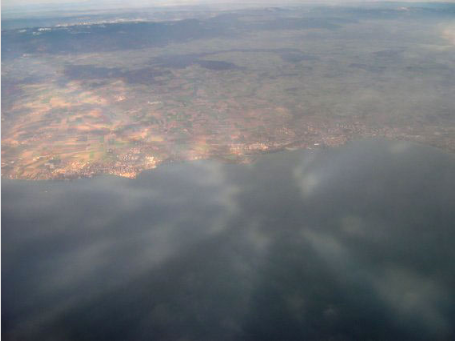Anti-crepuscular rays
Anti-Crepuscular Rays: A Phenomenon of Nature's Light Show
When it comes to atmospheric optics, there is no shortage of breathtaking phenomena that capture our imagination. One such phenomenon is the display of anti-crepuscular rays. While crepuscular rays are a well-known sight, often observed at sunrise or sunset, their lesser-known counterpart, anti-crepuscular rays, add another layer of intrigue to the ever-changing canvas of the sky.
Anti-crepuscular rays, also known as antisolar rays, are a captivating optical phenomenon where rays of sunlight appear to converge towards the point in the sky opposite to the position of the sun. These rays create a stunning visual effect, seemingly radiating from the anti-solar point and extending across the sky. This enchanting display can be observed when atmospheric conditions align perfectly, allowing us to witness nature's artistry.
The formation of anti-crepuscular rays is closely related to the interplay between sunlight and atmospheric particles. As sunlight passes through gaps in clouds or other obstructions on the horizon, it casts shadows that become visible as rays. Just like their more well-known counterparts, anti-crepuscular rays are a result of perspective. The parallel rays of sunlight converge due to the apparent convergence of perspective lines at the anti-solar point, creating an awe-inspiring effect.
To witness this captivating phenomenon, one must be in the right place at the right time. Anti-crepuscular rays are typically observed during sunrise or sunset when the sun is low on the horizon. However, they can also be seen during other times of the day under specific atmospheric conditions. It is important to note that the visibility of anti-crepuscular rays may vary depending on geographical location and weather conditions.
The precise conditions required for the formation of anti-crepuscular rays make them a relatively rare sight. The alignment of sunlight, atmospheric particles, and the observer's position must all come together in perfect harmony. When these conditions are met, the result is a breathtaking display that reminds us of the awe-inspiring beauty of our natural world.
It is fascinating to note that anti-crepuscular rays can appear to converge towards the anti-solar point from all directions. This phenomenon occurs due to the complex interplay of light and perspective. The apparent convergence of these rays creates an illusion of depth, adding an extra dimension to the spectacle.
Anti-crepuscular rays can be observed in various settings, whether in urban environments or in the midst of nature's splendor. From the cityscape to open fields or vast bodies of water, the convergence of these rays against the backdrop of the sky creates a mesmerizing scene. The reflection of anti-crepuscular rays on calm waters, like a serene lake or tranquil ocean, adds a touch of magic to the already enchanting display.
As with many atmospheric optics phenomena, photography plays a crucial role in capturing and documenting anti-crepuscular rays. Photographers who are fortunate enough to witness this captivating display often immortalize the moment, allowing others to marvel at the beauty of nature's light show. Through their lenses, they freeze time, capturing the ephemeral nature of anti-crepuscular rays for all to admire.
In conclusion, anti-crepuscular rays are a captivating atmospheric optics phenomenon that adds an extra touch of magic to nature's ever-changing canvas. These rays of sunlight seemingly converge towards the anti-solar point, creating a visual spectacle that leaves us in awe of the wonders of our world. While rare and dependent on specific conditions, witnessing this phenomenon is a reminder of the beauty that surrounds us and the intricacies of light and perspective. So, keep your eyes on the sky and be ready to witness this mesmerizing display when nature decides to put on its own light show.

Rays converge on the anti-solar point from all directions.
Philip Laven imaged these rays over Lake Geneva at 12.06 on November 10th 2003 when the sun was approximately 26º high. Image ©2003 Philip Laven, shown with permission.
Note: this article has been automatically converted from the old site and may not appear as intended. You can find the original article here.
Reference Atmospheric Optics
If you use any of the definitions, information, or data presented on Atmospheric Optics, please copy the link or reference below to properly credit us as the reference source. Thank you!
-
<a href="https://atoptics.co.uk/blog/anti-crepuscular-rays-5/">Anti-crepuscular rays</a>
-
"Anti-crepuscular rays". Atmospheric Optics. Accessed on November 26, 2024. https://atoptics.co.uk/blog/anti-crepuscular-rays-5/.
-
"Anti-crepuscular rays". Atmospheric Optics, https://atoptics.co.uk/blog/anti-crepuscular-rays-5/. Accessed 26 November, 2024
-
Anti-crepuscular rays. Atmospheric Optics. Retrieved from https://atoptics.co.uk/blog/anti-crepuscular-rays-5/.